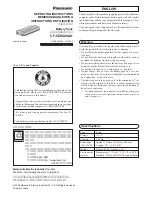
11
OPERATING THE CHARGER – 5 amp output
The LED Function Chart describes the charging process for any individual 5 Amp output.
Display
Operating condition
When the red LED is on, it indicates that your batteries are discharged and is
recharging them at the "Charging" rate (stage 1). This charging rate is 5
Amps.
While the red LED is on, the voltage measured (with the charger on) will be
approximately 11.5 to 13 Volts.
If the red LED stays on for more than 24 hours, refer to Problem 1 in the
troubleshooting section in this manual.
When both the green and the red LED’s are on, it is charging at the
"Finishing" rate. (stage 2). During this second charging stage, the charger
holds the battery voltage at approximately 14.8 VDC, and then gradually
reduces the amount of current (Amps) it delivers to the battery. By doing this,
the battery is able to “absorb” the last 10% of charge as quickly as possible
without becoming overheated.
If both lights stay on longer than 24 hours, refer to Problem 2 in the
troubleshooting section in this manual.
When the battery approaches full charge, the charger switches into its third
charging stage, gradually reducing the current fed to the batteries to as low as
0.1 Amps. At the same time, it reduces its output voltage to a “Float” or
“Ready” charging rate of approximately 13.3 VDC, indicated by the green LED
light. This low “
Float”
or
“Maintenance”
voltage gently “tops off” your
batteries, keeping them fully charged and ready until needed. Now you can
store your batteries at full charge indefinitely without overcharging. The green
LED indicates that your batteries are now fully charged and ready for use.
If the green LED stays on when your battery is known to be low, refer to
Problem 3 in the troubleshooting section in this manual.
Output Current
0
1
2
3
4
5
B
at
te
ry
V
ol
ta
ge
12.0
12.5
13.0
13.5
14.0
14.5
15.0
Charging Method for 5 Amp output
READY
CHARGING
FINISHING































